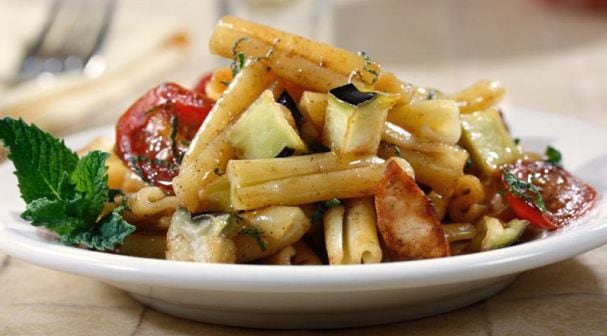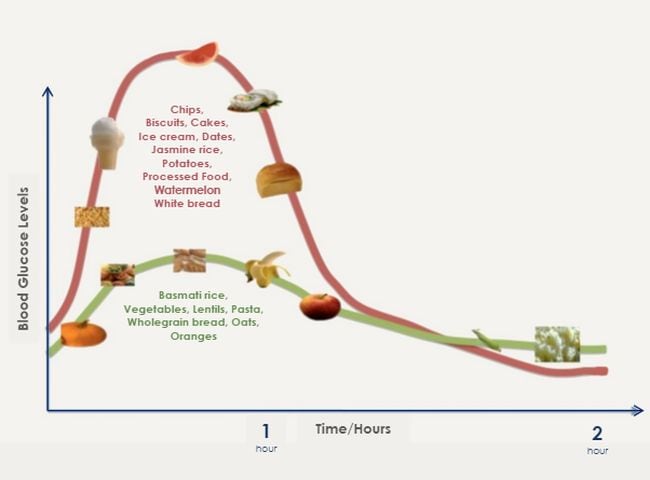In part because pasta tends to get lumped together with pies, cakes and pastries in the ‘refined grains’ category as a ‘white food’ as opposed to brown (eg. whole grains) or colorful (eg. fruits and veggies) foods, says Barilla, which says the authors of the 2015 Dietary Guidelines for Americans should help consumers understand that “not all refined grains are equal.”
Speaking to FoodNavigator-USA ahead of the launch of the guidelines, Barilla VP of R&D, Americas, Enrico Cademartiri, said many consumers think that regular pasta from refined grains (as opposed to whole grains) is little better than sugar- and fat-laden donuts or cookies, making them fat, and creating blood sugar spikes… followed by crashes.
In fact, at just 42-5, the glycemic index [GI] of regular pasta from refined grain is similar to that of buckwheat or brown rice and only slightly higher than that of whole grain pasta, which has a GI of 37, so is well below the threshold of 55 for low glycemic foods [foods that release energy slowly and keep you fuller for longer], said Cademartiri.
Regular pasta – from refined grains – is a low-GI food
This is in part because pasta’s starch structure causes it to be digested more slowly than the same amount of flour made into bread; while the extrusion process (which turns dough into pasta shapes) also creates a dense product that is less susceptible to digestive enzymes and has a lower GI than sheeted pasta, he said.
“The protein and the starch create a strong network that makes the microstructure of pasta really unusual. And cooked al dente, pasta’s GI index is also lower than if it’s overcooked. One way you can tell if you have a good quality pasta is if the water stays clear [instead of cloudy] as you cook it and the pasta is not sticky when you drain it, which means the starch remains trapped in the pasta.”
Pasta is made from enriched durum wheat + water, and has no added sugars, fats or sodium. The durum wheat is milled to remove the bran and germ leaving yellow endosperm (semolina) then ground into flour, mixed with water, kneaded, shaped and dried.
While the Dietary Guidelines for 2015 will almost certainly retain the “make half your grains whole” recommendation from 2010, they “may not address the appropriate way to consume refined grains (the other half)”, added Prita Wadhwani, senior integrated marketing manager at Barilla.
“Durum wheat is different from the grains in white rice or white bread; the protein in it helps to create a structure and texture that helps keep blood sugar steady. So we don’t want to see pasta lumped together with cookies, pies, pastries and snack foods in the ‘foods to eat less of’ category, because these are completely different foods.”

Contrary to popular belief, lack of color does not always indicate lack of nutrition, notes Barilla, pointing out that cauliflowers, onions, turnips, mushrooms, white beans, and white potatoes are all nutrient-dense foods … that happen to be white.
Indeed, confusion over pasta’s health credentials coupled with negative PR about grains generated by books such as Grain Brain and Wheat Belly are partly to blame for the lackluster performance of the category overall, which has declined very slightly over the past 10-15 years in volume terms despite the fact that pasta is simple and convenient to cook with, said Wadhwani.
However, there are pockets of growth in sub-categories such as gluten-free, high-protein, quick-cooking pasta and veggie pasta, and Barilla has developed products in all of these areas, said Cademartiri.
Carbs...the lowdown
COMPLEX CARBS, also known as polysaccharides, are starches and fibers formed by longer saccharide chains, which means they take longer to break down into glucose and tend to have a lower GI.
Examples: pasta, legumes, oats.
SIMPLE CARBS, or simple sugars are also known as monosaccharides, which include glucose, fructose and galactose, or disaccharides, which include sucrose (table sugar), lactose and maltose.They quickly convert to glucose and tend to have a high GI:
Examples: table sugar, soda, honey, candy.
But when it comes to wholegrain pasta, there are challenges to overcome, he added.

“People say they want to eat more wholegrain foods, but the wholegrain pasta segment isn’t actually growing, so this is why it is so important to overcome prejudices against wholegrain pasta. Because if they try a good quality wholegrain pasta like ours, they will view the segment differently.”
However, the biggest challenge facing the market is educating consumers that regular pasta – made from refined grain (where the bran and germ has been removed) – can be a key part of a healthy eating pattern, such as the Mediterranean diet, said Wadhwani.
“We want Americans to better understand the choices in the refined grains category.”
As consumers struggle with the concept of the glycemic index (GI), Barilla research suggests that the term ‘steady energy’ might resonate better with shoppers, who don't realize that pasta does not cause blood sugar spikes (followed by crashes), but can help you stay fuller for longer.
